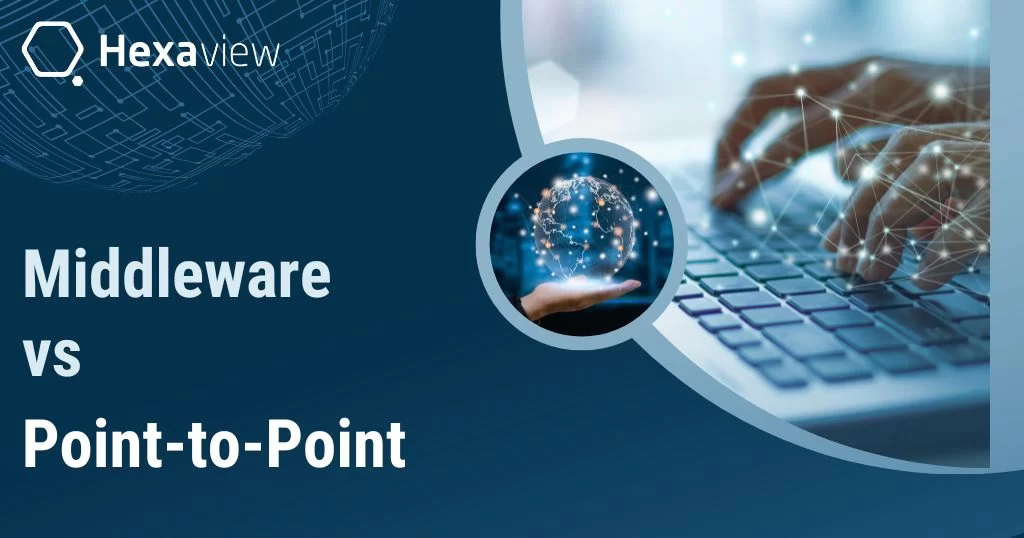416 total views
Point-to-Point integration allows data sharing between two systems. The mechanics of data delivery, as well as data transformation, are made easier by middleware.
Many of the people are still confused about when to employ middleware and point-to-point connectors. So, in this blog, we are going to disucss middleware and point to point integrations.
Importance of Middleware and Point to Point Integration
- You can add new features to your app and integrate it with external APIs using Point to Point integration without hiring a developer. Two to three of the apps in your company’s tech stack can be simply connected through point-to-point integration.
- Middleware act as a middleman between two applications. A middleware is an intermediary between dissimilar systems speaking different languages to come together for a goal, much like a real estate broker interfaces between the buyer and the seller or the landlord and the tenant.
Examples of standard middleware include transaction-processing monitors, message-oriented middleware, web middleware, database middleware, and application server middleware. Hexaview Technologies – a leading Salesforce development company offers Salesforce integration and Salesforce customization services to wide array of clients for multiple industries. You can reach out to them in case you have any enquiry related to Salesforce development services.
Point to Point to Integration
P2P integration, also known as point-to-point integration, uses customized code to link two programs. The code can be written using a variety of technologies, which enables your team to create a network of point-to-point integrations using a variety of coding languages.
Use Cases of Point to Point to Integration
- Development of new applications, optimization of current apps, thorough integration, etc.
- Data streaming. Application Programming Interfaces (APIs).
- Atomized Business Intelligence
Use Cases of Middleware Integration
- New application development
- Optimization of existing applications
- Comprehensive integration. …
- Application Programming Interfaces (APIs) …
- Data streaming. …
- Intelligent business automation.
Middleware Integration Advantages over to Point-to-Point Communication
- An illustration of middleware is a web server, which links websites to a backend database. Your computer transmits the request to the web server in XML or JSON when you submit a form on a website.
- A data interchange (or exchange) language or format is a domain-neutral language that can be used for data from any field. To better accommodate the encoding of metadata that describes the structural properties of the material, it has “developed from being markup and display-oriented.
Data Interchange Formats
- XML, GML,
- CSV is probably the most widely used form of import and export format for spreadsheets and databases.
- JSON.
- GeoJSON.
- Apache Parquet.Protocol Buffers (protobuf)
- YAML (Yaml ain’t markup language), a superset of JSON, is designed to be human-readable and commonly used for configuration files.
Major Differences of Middleware V/s Point-to-Point Integration
| Middleware | Point to Point |
| APIs can be thought of as a collection of tools that are used to facilitate integration between endpoints. However, it is crucial to note that integration must still be carried out in some manner. But middleware is a piece of software that connects two or more end points that need to be connected with one another. | Point-to-point A strongly connected integration between two or more endpoints allows for communication and the sharing of any data between the parties involved. When the potential uses are limited, it is quite beneficial. |
| Middleware is founded on the idea that there should be one central piece of software that interacts with each unique program and, in essence, translates, reformats, and restructures data as necessary as it is being transmitted from one application to another. | Point to Point integration becomes very complex to integrate. |
| To make the integration of new and legacy systems easier, middleware hides the complexity of the underlying operating system and network. Without having to go via numerous operating systems, networks, or resource server levels, it provides a way to link clients to servers, clients to clients, and servers to servers. | The PTP integration’s robust architecture enables replication operations that are quicker and more effective than those possible with middleware-based integration. |
Final Notes
In actuality, all viewpoints and strategies expressed in this blog are beneficial in all aspects of the business. By utilizing Artificial intelligence and other technologies that offers your company a measurable return on investment, you may add value to your company. In Salesforce, middleware plays a very crucial role in almost all the integrations, although we can also use point to point integrations in certain situations where a simple integration is needed with little data transformation and one-way or with very simple and highly segregated data ownership for simple synchronization scenarios. Reach out to Hexaview Technologies – a leading Salesforce customization company, in case of any doubt and integration challenges you are facing.
I hope through this blogs, I am able to shed some light on middleware vs point to point integrations.

